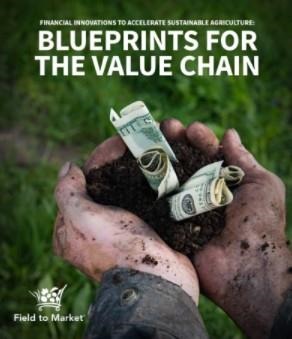A new report from Field to Market: The Alliance for Sustainable Agriculture highlights the need for innovative financial mechanisms and incentive strategies to help farmers and ranchers build on their already-impressive sustainability gains. The report, Financial Innovations to Accelerate Sustainable Agriculture: Blueprints for the Value Chain, provides 12 tangible blueprints and case studies for value chain actors to follow as they seek to catalyze lasting and systemic change in U.S. agriculture.

Authored by members of the Field to Market Innovative Finance Workgroup, the report shares concrete strategies to help farmers balance the risks and rewards of adopting or expanding sustainable agriculture practices. Among other things, the report addresses overcoming key barriers to farmer adoption of conservation practices, moving beyond early adopters and tackling the agronomic and financial risk farmers face in transitioning to the practices necessary for a more resilient food and agriculture system.
“As supply chain sustainability efforts to improve environmental outcomes through the supply chain continue to evolve, there is increasing attention on the economic barriers to the implementation of sustainable agriculture at scale,” said Scott Herndon, president of Field to Market. “The work of Field to Market’s Innovative Finance Workgroup continues to equip our members across the value chain with innovative and effective strategies to spur greater investment, collaboration and action to drive a more resilient agricultural system.”
Shelby Myers, economist at the American Farm Bureau Federation and co-chair of the Innovative Finance Workgroup, said the strategies shared in the report represent the beginning of an increasingly important discussion about farmers’ leadership in agricultural sustainability.
“Farmers and ranchers need voluntary, market-based solutions to drive forward their sustainability work and boost their resiliency. These solutions are just the start of an essential conversation for U.S. agriculture,” said Myers. “We hope these blueprints spark exploration of new incentive concepts and financial innovations to share in the risk and the reward of transition.”
The report details recommendations for financial innovations including:
- Blended finance approaches that combine public and corporate funds to support improved agricultural practices and increase the supply of sustainably produced crops.
- Sustainable finance mechanisms, including sustainable bonds and loans and agricultural lending incentives, that can allow companies and farmers to access favorable financing terms for sustainable projects and practices.
- Transition risk-sharing opportunities, including sustainability-linked crop warranties and crop insurance endorsements, that target specific risks associated with the adoption of new conservation practices.
- Pay for performance programs that pay farmers directly for quantified environmental benefits.
- Leasing incentives that allow farm operators and landowners to share the costs and benefits of conservation investments over time.
“Farmers who adopt sustainable practices are generating real value, but they also face barriers in making the transition to new practices,” said Maggie Monast, senior director of climate-smart agriculture at Environmental Defense Fund and co-chair of the Innovative Finance Workgroup. “This report provides actionable insights for the value chain into how public and private financial sources of capital and a careful blend of incentives can be used to accelerate conservation adoption at scale.”
The report concludes with questions to guide the action and implementation plans of companies interested in harnessing innovative financial incentives to accelerate sustainable outcomes, as well as three key recommendations:
- Engage existing financial partners throughout the value chain in discussions about sustainability.
- Experiment and pilot innovative financial mechanisms and diversified incentive strategies tailored to address farmer needs, challenges and motivations.
- Share results to spur further adoption and innovation across the industry.
“There is an essential need in front of all of us to unlock the next suite of innovations to ensure we continue to yield equal value for farmers and nature,” says Brandon Hunnicutt, a fifth-generation Nebraska farmer and chair of Field to Market. “This research and discovery by Field to Market’s Innovative Finance Workgroup has identified a dozen financial strategies that deserve greater collective focus, resources and action across the value chain to collectively pursue solutions that create wins for farmers, business, society and our planet.”
Click here to see more...